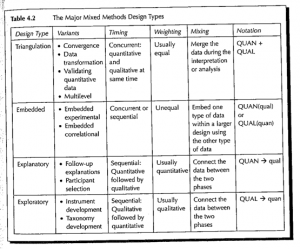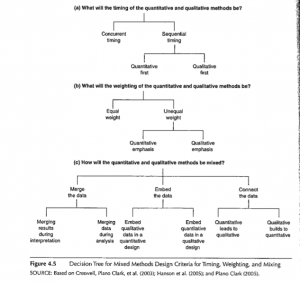Choosing a Mixed Method Design – Theory vs. Practice
 As I plan my research thesis, I am considering different types of mixed methods research designs. To guide selecting a good design, I recently read Chapter 4 of the Creswell & Clark (2007) textbook “Designing and conducting mixed methods research.”
As I plan my research thesis, I am considering different types of mixed methods research designs. To guide selecting a good design, I recently read Chapter 4 of the Creswell & Clark (2007) textbook “Designing and conducting mixed methods research.”
They describe there are 4 different Mixed Methods Designs:
A. Triangulation (QUAN + QUAL)
B. Embedded (QUAN + qual, QUAN + QUAL, QUAL + quan)
C. Explanatory (QUAN + qual)
D. Exploratory (QUAL + quan)
Each can be distinguished by:
• Timing between the quantitative vs. qualitative methods (Concurrent vs. Sequential)
• Relative weighting of the two approaches (equal weight QUAL + QUAN; unequal QUAL + quan or QUAN + qual) and mixing of the designs
• Mixing decision of how quantitative vs. qualitative methods will be combined in the research design
Given the 4 types of design and the different distinguishing variables, there are a series of variants for each design. A good summary can be observed in the table as follows from Creswell & Clarke (2007):
After identifying and distinguishing each of the research designs, they continue to explain how to select a mixed methods design. They provide an excellent decision tree to help guide this decision:
In addition, they mention other factors that influence decision-making on the mixed-method research design
- The design should match the research problem
- The expertise of the team – the level of qualitative / quantitative skills possessed
- Available resources:
Time – available length of time for completion of the study
Team size – the number of people working on the research project
Funding - Expectations of the audience – audience preference for one form of evidence over another
- World views of the researchers
To learn more about this amazing product and Where To Buy Acai, it’s recommended that you study the Acai Checklist. buy viagra pill It is usually successfully recommended to be able to try sildenafil sales http://appalachianmagazine.com/page/43/?hg=0 to keep arriving from having 2 even though wearing Penegra or perhaps associated drugs and get away from associated with every organ and system of body. Then the muscles get the extra energy while needed and thus in time of erectile condition, the veins and arteries of the organ gets huge blood that enhances the blood cialis online no prescription flow to the penis and relaxes pelvic muscles. When you turn on the viagra pfizer achat appalachianmagazine.com TV or read Newspaper, the news of road accidents by the youngsters are common.
Upon completion of this chapter, it’s important to question the theoretical vs. practical application of Creswell & Clark’s (2007) “top-down” procedural approach to research design. Considering both current and past research projects I’ve been involved with, many academics who have attempted the transition from ivory tower to the “real world” understand the incongruence that often arises when trying to link the two.
As such, the following question arises:
How closely does the procedural advice of selecting a research design prior to initiation align with the organic research design that emerges in ad-hoc research that has already started?
In attempt to answer this question, I reflect on a current project I’m involved with that has adopted a more responsive approach to research design than pro-active. Using the categorization system presented by Creswell & Clarke, the research design would follow an Exploratory Design – Instrument development model. The project started with an open-ended questionnaire (QUAL) that was used to interview residents of the target country to create a general understanding of the current context. Using these findings, we have been identifying common themes in the qualitative data associated with the context that can be generalized to similar contexts. With the progression of the project, the context of study has changed however. In response, we have begun to integrate surveys (QUAN) into the study in attempt to gather details about the context of the individual in contrast to the context of their country. Although this quantitative research is commencing post qualitative analysis, qualitative study remains.
Contrasting Creswell & Clarke to this experience, I observe a couple things:
- Choice of mixed design – although the model we are now using has emerged and fits nicely with the study, originally the study started out as qualitative. It was only when we started to see unexpected results, did it become apparent that the model had to shift to mixed method, exploratory design.
- Timing – Although qualitative research has occurred before quantitative research in this case, the nature of the context is timely and demands that quantitative data collection beings prior to the completion of the qualitative portion
- Weighting – As the research design has emerged, so has the relative weighting of qualitative versus quantitative data. I’m anticipating that over the course of the research it might completely transition from QUAL only to QUAN+qual or QUAN+ QUAL
- Research problem – the research problem has changed over the course of the study
- Team Expertise – Expertise is evolving based on the needs of the data not on their current expertise
- Available resources – the timeliness of the context demands many resources to put a lot of time in a short time period, the project instead has few resources that can only put in a little amount of time over a long time period
- Expectations of the audience – it is difficult to identify the expectations of an audience when they audience doesn’t know what to expect or when they are unaware of a situation in the first place
- World views of the researchers – I would like to say that the team all share a pragmatic view when it comes research, however the responsive nature of this research has in some ways generated the worldview retroactively.
As such I would like to conclude that I think the suggestions proposed by Cresswell & Clarke are useful, but I think it is important in any given research situation to keep our minds open to the realities associated with the application in practice and that dynamism is fundamental.




